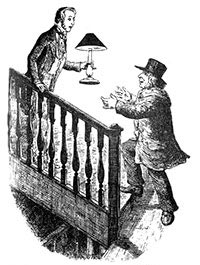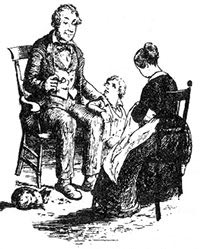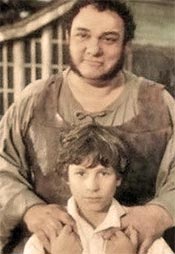The Charles Dickens Page
Charles Dickens'
Great Expectations
A Masterpiece...and a Bit of Autobiography
Great Expectations - Published in weekly parts Dec 1860 - Aug 1861
Illustrations | Locations | Plot | Characters | More | Shop for the Book | Shop for the Video
Charles Dickens' thirteenth novel was published in Dickens' weekly journal All the Year Round without illustrations. An American edition was also published, curiously, a week in advance of the English version, in Harper's Weekly (Patten, 1978, p. 289).
The novel contains a strong autobiographical element, though not as openly as in David Copperfield. Dickens reread Copperfield before beginning Great Expectations to avoid unintentional repetition (Johnson, 1952, p. 965). Called Dickens' darkest work by some, it was very well received by Victorian readers and remains one of Dickens' most popular works today. Many consider this novel Dickens' greatest use of plot, characterization, and style and Great Expectations the masterpiece of Charles Dickens' works (Davis, 1999, p. 153).
Plot
(contains spoilers)
Pip, an orphan, is brought up by his abusive sister and her husband, Joe Gargery, the kindly village blacksmith. Magwitch, an escaped convict, confronts Pip in the churchyard on the Kent marshes and demands food and a file to break his chains. Out of fear Pip complies and Magwitch escapes. He is soon recaptured and transported to Australia where he prospers.
Pip is introduced to Miss Havisham, an eccentric old woman, and her charge, Estella, with whom Pip falls in love. Estella has been taught by Miss Havisham to break men's hearts as restitution for Miss Havisham's having been left at the altar years before by Compeyson, who later turns out to be a convict who was once partnered with Magwitch.
Pip is apprenticed to Joe but longs to become a gentleman after having been made to feel inferior by Estella who had criticized Pip's "coarse hands and thick boots." He begins to be ashamed of Joe and home and enlists Biddy to help educate him.
Pip and Joe meet the lawyer, Jaggers, at the local pub. Pip recognizes Jaggers as a man he has seen at Miss Havisham's. Jaggers relates to Pip and Joe that Pip has great expectations through an unnamed benefactor which Pip assumes is Miss Havisham. Jaggers tells them that Pip is to be released from his apprenticeship to Joe and become a gentleman and is to go to London to begin his education. As part of the mysterious circumstances of his great expectations Pip is told that he is not to try to discover who his benefactor is.
Pip goes to London where Jaggers and his clerk Wemmick set him up to begin his education with Matthew Pocket, who is Miss Havisham's cousin. Pip has chambers with Matthew's son Herbert at Barnard's Inn and discovers Herbert is the "pale young gentleman" he had scuffled with at Miss Havisham's Satis House. Pip's sister, Mrs Joe Gargary, has been attacked by Orlick, a journeyman blacksmith in Joe's shop. She lingers in a state of insensibility and later dies.
Pip continues and finishes his education and secretly sets Herbert up in business. He becomes Estella's escort in London and continues to adore her as she continues to torment him. When Pip turns 21, and reaches his majority, he is told by Jaggers that he is to receive 500 pounds per year from his still unnamed benefactor. Pip wonders when Miss Havisham will make herself known as the provider of his great expectations and he will come into his promised property.
On a stormy night in his 23rd year Pip is home alone and is visited by a man who seems to know him, but whom Pip does not recognize. Finally, to his horror, Pip recognizes the convict Magwitch and, to his further horror, Magwitch relates that it was he who has provided Pip's great expectations. Magwitch has returned to England, in violation of his sentence of transportation, to see the gentleman he has made.
Pip learns that Estella will marry the hated Bentley Drummle. Estella quarrels with Miss Havisham over her heartless upbringing. Later Miss Havisham is repentant and begs Pip to forgive her. Pip rescues her when her clothes catch fire but she is badly burned and later dies. Pip's arms were also badly burned and he recovers slowly. Estella's marriage goes badly, she is mistreated by Drummle and she leaves him. Drummle later dies in an accident involving the mistreatment of a horse.
Pip enlists Herbert to help him find lodging to hide the convict, now called Provis, until they can spirit him abroad. They lodge Provis in an upstairs room in a house at Mill Pond Bank, on the Thames, occupied by Herbert's fiancee Clara and her invalid father. They then make plans to take Provis down the river in an open boat and catch a steamer bound for Hamburg.
On the way they are overtaken and Provis identified as the convict Magwitch by Compeyson. Compeyson drowns when he and Magwitch scuffle and fall from the boat. Magwitch sustains serious injury. Despite his health, Magwitch is tried and sentenced to death but dies of his wounds before the execution can be carried out. Pip has learned that Magwitch is Estella's father and, now softened towards the convict, tells him of his daughter just before Magwitch dies.
Magwitch's wealth, which was intended for Pip, is confiscated by the Crown and leaves Pip destitute and ill. Joe comes to care for Pip in his illness and for a while it is like the old days at the forge. Pip is truly sorry for having forgotten Joe, Biddy and home. When his strength returns he decides to ask Biddy to marry him. On arrival at the forge he finds that Biddy has married Joe.
Pip leaves England to take a clerk's position in Herbert's firm. After many years he returns to visit Joe and Biddy at the forge and finds a copy of himself, Joe and Biddy's son, sitting in his old corner in the kitchen firelight. He visits Satis House, now in ruins, and meets a now softened Estella with the "freshness of her beauty gone but its indescribable majesty and its indescribable charm remaining" and sees "no shadow of another parting from her."
Complete List of Characters:
Character descriptions contain spoilers
Great Expectations
Further Information
Map of Charles Dickens' Great Expectations Connections
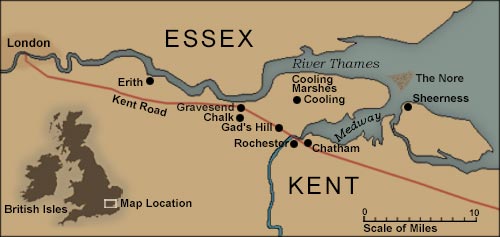
Rochester - Pip's village located near here.
Chalk - Model for Gargery's forge located here. Dickens honeymooned here in 1836.
Cooling - Cooling churchyard is where Pip's family is buried, Pip meets Magwitch here.
Chatham - Dickens lived here as a child.
Gads Hill - Dickens walked with his father by a mansion here as a child. Dickens bought the house in 1856 and lived there the last 12 years of his life.
Kent Road - Route Pip takes between London and home.
Thames - Pip practices rowing between London and Erith. Attempt to escape with Magwitch from London to near the Cooling Marshes.
The Nore - Sandbank off the Isle of Grain.
Great Expectations Links:
Wikipedia
eNOTES
The Victorian Web
BookRags.com - Great Expectations
Bartleby.com
SparkNotes - Excellent!
Universal Teacher Study Guide
Great Expectations Excerpt:
Dickens hilarious account of the formerly illiterate Joe composing a letter:
Evidently, Biddy had taught Joe to write. As I lay in bed looking at him, it made me, in my weak state, cry again with pleasure to see the pride with which he set about his letter. My bedstead, divested of its curtains, had been removed, with me upon it, into the sittingroom, as the airiest and largest, and the carpet had been taken away, and the room kept always fresh and wholesome night and day. At my own writing-table, pushed into a corner and cumbered with little bottles, Joe now sat down to his great work, first choosing a pen from the pen-tray as if it were a chest of large tools, and tucking up his sleeves as if he were going to wield a crowbar or sledgehammer.It was necessary for Joe to hold on heavily to the table with his left elbow, and to get his right leg well out behind him, before he could begin, and when he did begin, he made every down-stroke so slowly that it might have been six feet long, while at every up-stroke I could hear his pen spluttering extensively. He had a curious idea that the inkstand was on the side of him where it was not, and constantly dipped his pen into space, and seemed quite satisfied with the result. Occasionally, he was tripped up by some orthographical stumbling-block, but on the whole he got on very well indeed, and when he had signed his name, and had removed a finishing blot from the paper to the crown of his head with his two forefingers, he got up and hovered about the table, trying the effect of his performance from various points of view as it lay there, with unbounded satisfaction
(Great Expectations, p. 440).
The original manuscript of Great Expectations
Charles Dickens gave the bound manuscript of Great Expectations to his friend Reverend Chauncy Hare Townshend in 1861. When Townshend died in 1868 he bequeathed the manuscript to the Wisbech & Fenland Museum.
Story Foretold
Charles Dickens wrote to his friend and advisor, John Forster, telling his plan for Great Expectations:
"The book will be written in the first person throughout, and during these first three weekly numbers you will find the hero to be a boy-child, like David. Then he will be an apprentice. You will not have to complain of the want of humour as in the Tale of Two Cities. I have made the opening, I hope, in its general effect exceedingly droll. I have put a child and a good-natured foolish man, in relations that seem to me very funny. Of course I have got in the pivot on which the story will turn too -- and which indeed, as you remember, was the grotesque tragicomic conception that first encouraged me. To be quite sure I had fallen into no unconscious repetitions, I read David Copperfield again the other day, and was affected by it to a degree you would hardly believe" (Forster, 1899, v. 2, p. 356).
Beggar My Neighbor
 Miss Havisham has Pip and Estella play Beggar My Neighbor to entertain her. Estella uses the game to make Pip aware of how common he is:
Miss Havisham has Pip and Estella play Beggar My Neighbor to entertain her. Estella uses the game to make Pip aware of how common he is:
"He calls the knaves, Jacks, this boy!" said Estella with disdain, before our first game was out. "And what coarse hands he has! And what thick boots!" I had never thought of being ashamed of my hands before; but I began to consider them a very indifferent pair. Her contempt for me was so strong, that it became infectious, and I caught it. She won the game, and I dealt. I misdealt, as was only natural, when I knew she was lying in wait for me to do wrong; and she denounced me for a stupid, clumsy labouring-boy (Great Expectations, p. 55).
The Forge
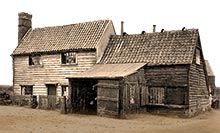 Dickens used the forge at Chalk Village as the model for Joe Gargary's forge in Great Expectations (Slater, 2009, p. 68).
Dickens used the forge at Chalk Village as the model for Joe Gargary's forge in Great Expectations (Slater, 2009, p. 68).
The Two Endings
The ending of Great Expectations that Victorians read is not the original ending that Charles Dickens wrote for the novel. On the advice of his friend, novelist Edward Bulwer-Lytton, Dickens changed the original ending where Pip meets the remarried Estella in London and they part forever, to the more upbeat ending where Pip and Estella stay together (Johnson, 1952, p. 968-969).
Dickens friend and biographer, John Forster, revealed the original ending in his The Life of Charles Dickens after Dickens' death (Forster, 1899, v. 2, p. 361). Most critics believe the original ending more suitable to the dark nature of the story. Modern editions of the novel usually include the original ending as an addendum.
Pip and Joe
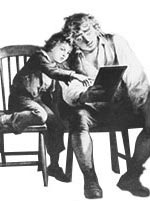 One of the strongest themes in Great Expectations is Pip's relationship with Joe Gargary. Joe offers unconditional love while Pip, grown callous in the face of his great expectations, has to relearn the value of Joe's friendship...what larks!
One of the strongest themes in Great Expectations is Pip's relationship with Joe Gargary. Joe offers unconditional love while Pip, grown callous in the face of his great expectations, has to relearn the value of Joe's friendship...what larks!
Transportation
Transportation was the practice of sending British criminals to the colonies as punishment in the absence of sufficient prisons. Criminals were sent to America until 1776, after that date they were sent to Australia. It is estimated that 140,000 criminals were transported to Australia between 1810 and 1852.
Transported criminals were consigned to private employers for a fixed period of time according to their crimes. Abel Magwitch, in Great Expectations, had been transported to Australia, finished his sentence, and became rich working for himself. Still, his return to Britain was punishable by death until 1834, although the last actual hanging for this offense took place in 1810. Transportation was abolished in 1857 (Wikipedia).
Satis House
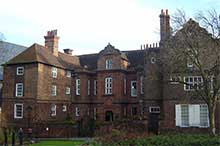 Charles Dickens modeled Miss Havisham's Satis House on Restoration House in Rochester. Charles II stayed at Restoration House on his return to England from Holland in 1660, restoring the English monarchy after the reign of Oliver Cromwell (Wikipedia).
Charles Dickens modeled Miss Havisham's Satis House on Restoration House in Rochester. Charles II stayed at Restoration House on his return to England from Holland in 1660, restoring the English monarchy after the reign of Oliver Cromwell (Wikipedia).
All the Year Round
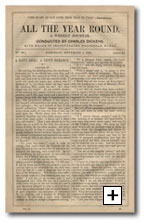 Charles Dickens chose to publish Great Expectations in his weekly magazine All the Year Round rather than in the traditional monthly parts in order to revive slumping sales of the weekly. All the Year Round, which Dickens served as editor and publisher, featured general interest articles along with serialized novels by various authors. The novel serialized immediately preceding Great Expectations, A Long Day's Ride, by Charles Lever, was not popular with readers, producing the sales slump (Ackroyd, 1990, p. 883).
Charles Dickens chose to publish Great Expectations in his weekly magazine All the Year Round rather than in the traditional monthly parts in order to revive slumping sales of the weekly. All the Year Round, which Dickens served as editor and publisher, featured general interest articles along with serialized novels by various authors. The novel serialized immediately preceding Great Expectations, A Long Day's Ride, by Charles Lever, was not popular with readers, producing the sales slump (Ackroyd, 1990, p. 883).
The decision to publish Great Expectations in the weekly lead to a more tightly written novel, without the multiple subplots which were a staple of Dickens' longer novels. Publication in the weekly magazine revived sales of All the Year Round and produced a novel distinctly different than if it had been published monthly.
Dickens had previously published A Tale of Two Cities in All the Year Round.
Charles Dickens' life during the serialization of Great Expectations
Dec 1860 - Aug 1861Dickens' age: 48-49
December 1860
The appearance of Great Expectations revives sales of Dickens' weekly journal All the Year Round (Slater, 2009, p. 491).
March - April 1861
Dickens gives six public readings in St James's Hall, Piccadilly (Johnson, 1952, p. 968).
May 1861
Takes a steamer excursion with family and friends from Blackwall to Southend noting details of the riverside in preparation for writing of Magwitch's attempted escape (Forster, 1899, v. 2, p. 359).
June 1861
With the story complete, Dickens decides to change the ending, on the advice of Edward Bulwer-Lytton (Johnson, 1952, p. 968-969).
August 1861
River Research for Great Expectations
John Forster, in his The Life of Charles Dickens, tells of Dickens hiring a steamer to ensure accuracy in telling of Magwitch's attempted escape:
At the opening of the story there had been an exciting scene of the wretched man's chase and recapture among the marshes, and this has its parallel at the close in his chase and recapture on the river while poor Pip is helping to get him off.
To make himself sure of the actual course of a boat in such circumstances, and what possible incidents the adventure might have, Charles Dickens hired a steamer for the day from Blackwall to Southend. Eight or nine friends and three or four members of his family were on board, and he seemed to have no care, the whole of that summer day (22 May, 1861), except to enjoy their enjoyment and entertain them with his own in shape of a thousand whims and fancies; but his sleepless observation was at work all the time, and nothing had escaped his keen vision on either side of the river (Forster, 1899, v. 2, p. 359).
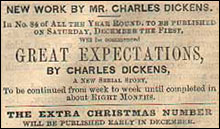
Advertisement for the upcoming serialization of Great Expectations in Charles Dickens' weekly journal All The Year Round-November 1860. The weekly installments began the following month.
Great Expectations2
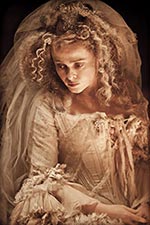 2012, the bicentenary of Charles Dickens' birth, saw the release of two film adaptations of Great Expectations. The first starred Gillian Anderson, Ray Winstone, and Douglas Booth. The second starred Helena Bonham Carter and Ralph Fiennes.
2012, the bicentenary of Charles Dickens' birth, saw the release of two film adaptations of Great Expectations. The first starred Gillian Anderson, Ray Winstone, and Douglas Booth. The second starred Helena Bonham Carter and Ralph Fiennes.


